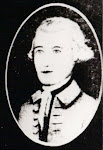Stephen Moore’s birth, 30 Oct 1734, is noted in daughter Mary Moore Stanford’s bible but little else is known of his early childhood or adolescence until the death of his father, Col. John Moore, when Stephen inherited the West Point property bequeathed to him at the age of fifteen. The memoirs of John Moore, Esq., Stephen’s nephew, recount that Stephen was “brought up in business” by the Hon. John Watts. This apprenticeship may have spanned Stephen’s mid- to late teen years. Stephen Moore’s name does not appear in the alumni lists of Oxford or Cambridge. He may have been tutored for his early education. But well-educated he assuredly was, as evidenced by his many letters, ledgers, petitions, memorials and account books. His handwriting is beautiful, legible and quite distinctive, making it instantly recognizable.
While searching for the deeds to all the properties mentioned in the last will and testament of Col. John Moore of New York City, I came across a deed for a house and lot that Col. John Moore sold to Elizabeth Johnston before he made his will. New York City deeds are recorded in three different record groups: NYC Conveyances 1654-1866, includes deeds for New York City and New York County; Deeds in the Secretary of State’s Office, 1659-1846; and Patents of the State of New York in the Secretary of State’s Office, 1708-1973. These are all accessible on microfilm, available in various repositories or through Family History Centers of the LDS Church (Mormons). A fourth record group is presently only available at the New York Municipal Archives in NYC: City Grants Libers 1686-1907. Liber B 1701-1752, pages 109-113, records the grant/deed for the lot on which Col. John Moore built his “mansion” called Whitehall. This was not the same Whitehall that belonged to Peter Stuyvesant almost a century before. That Whitehall was destroyed by fire in 1717. Presumably, Col. John Moore named his house Whitehall because the lot was very near Whitehall Slip. The house was hardly a mansion by today’s standards but when it was built, it would have been considered grand. It was a three story house on a lot measuring 31’ 6” by 168’. It served as the Custom House from May 1769 until the fire of September 1776.
The search for deeds to properties owned by Col. John Moore entailed reading deed books from the above named records groups, aided by indexes for the most part. In the Secretary of State Deeds, Vol. 16:42, is a power of attorney recorded for Lambert Moore, Stephen Moore’s brother, dated 1757. It was written in the familiar, distinctive hand of Stephen Moore himself. Subsequent study of other deed books revealed that Stephen was the scribe on all or part of 3 different Secretary of State Deed volumes, and 3 of the Secretary of State Patent Books spanning dates from about 1757 to 1786. But how had he accomplished this? He had been in New York, Quebec and North Carolina during that span of years. Apparently, Stephen Moore began his work as a scribe or clerk as a young adult or while he was apprenticed to Hon. John Watts. He joined the New York Provincial Troops as a Lieutenant in 1757, possibly retaining his position with John Watts who served as a provision contractor for the Army. Eventually, Stephen was appointed Deputy Paymaster for the British Army in Canada about 1760. He remained in Canada until 1770, but made frequent trips to New York. He resided at his West Point estate from 1770 until sometime in late 1775 or early 1776, when he moved his family to North Carolina. In December, 1779 Stephen Moore first petitioned Congress, sitting at Philadelphia, for compensation for the loss of income as well as damages done to his West Point estate. This was the first of many petitions and memorials that ultimately led to the sale of the West Point estate to the US government in 1790, requiring Stephen to make many trips to New York to press his case. The explanation for how he accomplished the task of transcribing the records spanning all these years when he was residing elsewhere is found in the Patent Books. Volumes 5, 6 & 7 were all transcribed entirely by Stephen Moore. At the beginning of each of the volumes is “An Act for transcribing Certain Records of Patents passed the 23rd February 1786” detailing the need to copy all the old deed and patent books that were deteriorating from use. Stephen Moore used the time he was in New York well and supplemented his income, too. Some of the volumes have notations in the margin of the dollar amount each transcription was worth.
Submitted by Terri B. O’Neill, 2009 ©
Subscribe to:
Post Comments (Atom)









2 comments:
How can one obtain copies of Stephen Moore's documents in his handwriting please?
Steve Kelly
Ridgeland, MS
Steve,
Scattered throughout posts on this blog are some documents penned by Stephen Moore. Those you can print by right-clicking on the document and sending it to your printer. You will note in this post by Terri O'Neill references to microfilm or libraries where original documents can be found. You can contact them directly for photocopies of the documents. Many of these are contained in the Duke University Library archives and the Southern Historical Collection in the UNC Wilson Library in Chapel Hill, but there are many other repositories as well.
In the future, more articles on original research will be published, so "stay tuned." Upcoming is an article on the acquisition of land parcels by Stephen Moore constituing his large estate at Mt. Tirzah, and the disposition of that estate to his heirs. Don't be surprised when you see the author's name is also Stephen Moore.
Thank you for your question.
Post a Comment